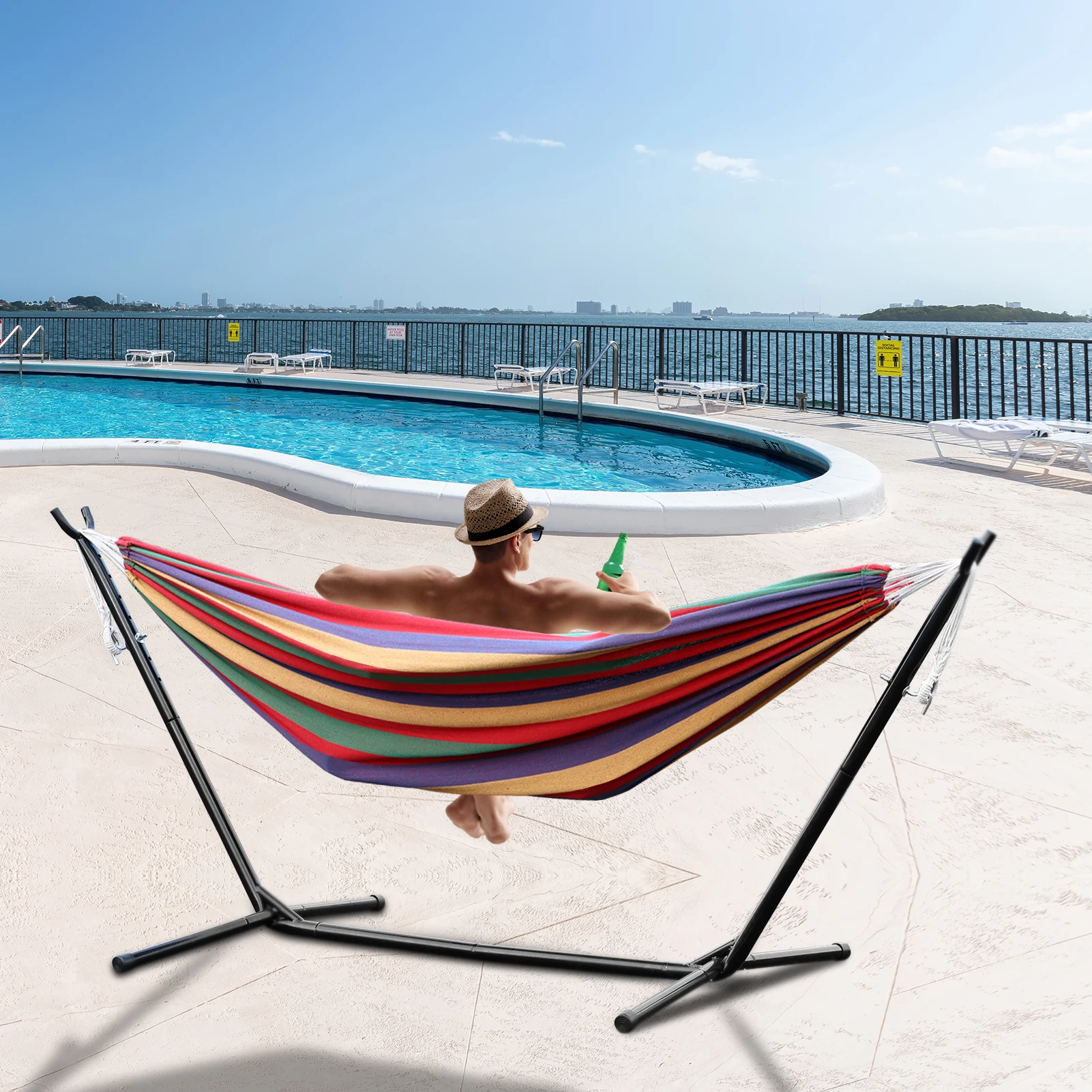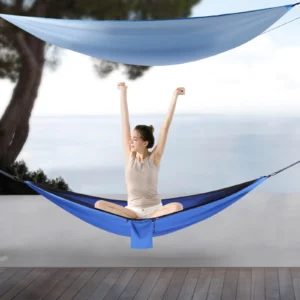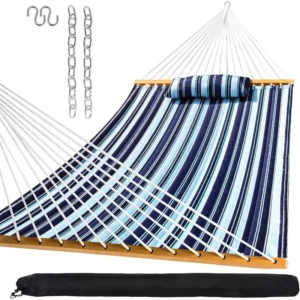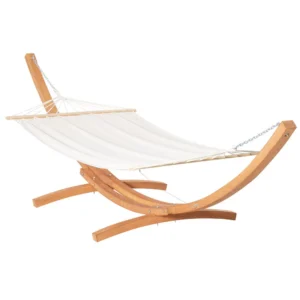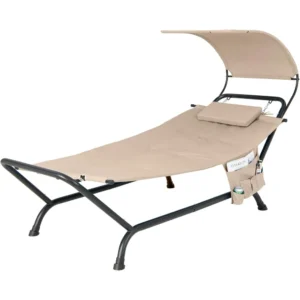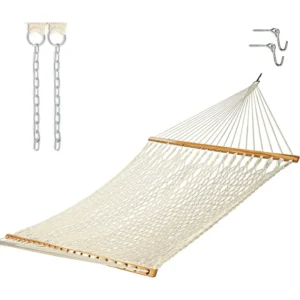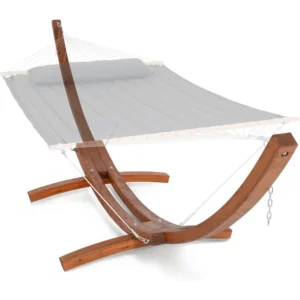1. Introduction: Why Fabric Selection Matters for Outdoor Hammocks
There’s nothing quite like the gentle sway of a hammock on a perfect afternoon. The simple pleasure of lounging outdoors, suspended in comfort, creates a personal retreat that invites relaxation. However, that peaceful experience depends largely on one critical factor: the fabric of your hammock.
The material choice for your outdoor hammock isn’t just about aesthetics—it’s the foundation of your relaxation experience. The right fabric ensures:
- Durability against nature’s challenges
- Comfort against your skin in various weather conditions
- Resistance to outdoor elements like UV rays and moisture
- Long-term value for your investment
Outdoor hammocks face considerable challenges. The constant exposure to sunlight can break down fibers and fade colors. Rain, morning dew, and humidity can promote mold growth. Temperature fluctuations can stress materials over time. With these challenges in mind, choosing the appropriate fabric becomes essential rather than optional.
With proper fabric selection, your hammock can last for many years instead of just a few seasons. The difference can be dramatic—the wrong fabric might deteriorate in months, while the right choice could provide a decade of relaxation.
This guide will walk you through everything you need to know about outdoor hammock fabrics. We’ll explore the key properties to look for, analyze popular fabric types, compare natural versus synthetic options, and provide practical advice for matching your fabric to your specific climate and usage needs. Whether you’re a first-time hammock buyer or looking to upgrade, this information will help you make a choice you’ll be happy with for years to come.
Understanding whether it’s okay to leave your hammock outside is directly connected to the fabric it’s made from—which is exactly what we’ll explore in this guide.
For immediate options, browse our selection of premium fabric hammock sets designed specifically for outdoor enjoyment.
2. Key Properties to Look for in Outdoor Hammock Fabrics
Before diving into specific fabric types, understanding the essential properties that make a fabric suitable for outdoor use will help you make an informed decision. These properties determine how well your hammock will perform over time in outdoor conditions.
Weather Resistance Properties
UV Resistance
Constant exposure to sunlight can quickly degrade fabrics not designed for outdoor use. Good UV-resistant fabrics prevent:
– Color fading and discoloration
– Fiber breakdown that leads to tearing
– Loss of tensile strength over time
Water Resistance and Quick-Drying
Outdoor hammocks inevitably encounter moisture. Water-resistant fabrics offer:
– Protection against rain and morning dew
– Quick-drying capabilities to prevent mold growth
– Reduced likelihood of mildew development
– Maintenance of strength when wet
Temperature Stability
Quality outdoor fabrics maintain their integrity through:
– Hot summer days without becoming brittle
– Cold nights without becoming stiff
– Resistance to cracking in temperature fluctuations
Durability Factors
Tear and Abrasion Resistance
The physical strength of fabric determines how well it handles:
– Daily use and body weight
– Accidental snags or pets jumping in
– Friction against tree straps or stands
Weight Capacity
Fabric strength directly impacts how much weight a hammock can safely support. This is often measured in Denier (D), which indicates the thickness of the fibers. For example:
– 70D nylon might support a single person up to 300 lbs (136 kg)
– 210D nylon can often handle 400+ lbs (181+ kg)
– Higher denier ratings generally indicate stronger fabrics
Thread Count and Weave Structure
The construction method affects performance:
– Tight weaves resist stretching and tearing
– Ripstop patterns prevent small tears from spreading
– Double or triple-stitched seams increase overall strength
Comfort Considerations
Softness
The fabric’s feel against your skin matters for relaxation:
– Some synthetics can feel slippery or stiff
– Others are engineered to mimic the softness of natural fibers
– Texture can affect how easily you can get comfortable
Breathability
Air circulation through the fabric affects comfort in different weather:
– In hot weather, breathable fabrics prevent overheating
– In humid conditions, they reduce the sticky feeling
– They help regulate body temperature during use
Support vs. Comfort Balance
The ideal outdoor hammock fabric finds the sweet spot between:
– Being firm enough to provide proper support
– Being flexible enough to conform to your body
– Maintaining this balance after months of use
Understanding these hammock weight capacity guidelines can help ensure you select a fabric that meets your specific needs.
3. Popular Fabrics for Outdoor Hammocks: Detailed Analysis
3.1. Synthetic Fabrics
3.1.1. Polyester
Polyester has become one of the most popular choices for outdoor hammocks due to its excellent balance of durability, weather resistance, and value.
Composition and Manufacturing
Polyester is a synthetic polymer made from petroleum-based products. The manufacturing process creates strong, uniform fibers that can be woven into various thicknesses and patterns. These fibers are naturally hydrophobic (water-repelling) and have good tensile strength.
Key Strengths
– Outstanding UV resistance that prevents color fading and material breakdown
– Excellent resistance to mildew, mold, and rot
– Maintains strength when wet and dries quickly after rain
– Generally more affordable than specialized outdoor fabrics
– Available in various weights, colors, and patterns
– Often treated with additional weatherproofing
Limitations
– Not as soft against skin as cotton or premium synthetics
– Can feel hot during extended contact in warm weather
– Less breathable than natural fibers
– Moderate stretch that may require readjustment over time
Specific Use Cases
Polyester hammocks excel in:
– Year-round outdoor installations
– High-sun environments where UV damage is a concern
– Family use where durability matters
– Budget-conscious options that don’t sacrifice weather resistance
Care Requirements
– Typically machine washable on gentle cycles
– Quick to dry after cleaning
– Resistant to most stains
– Minimal maintenance required beyond occasional cleaning
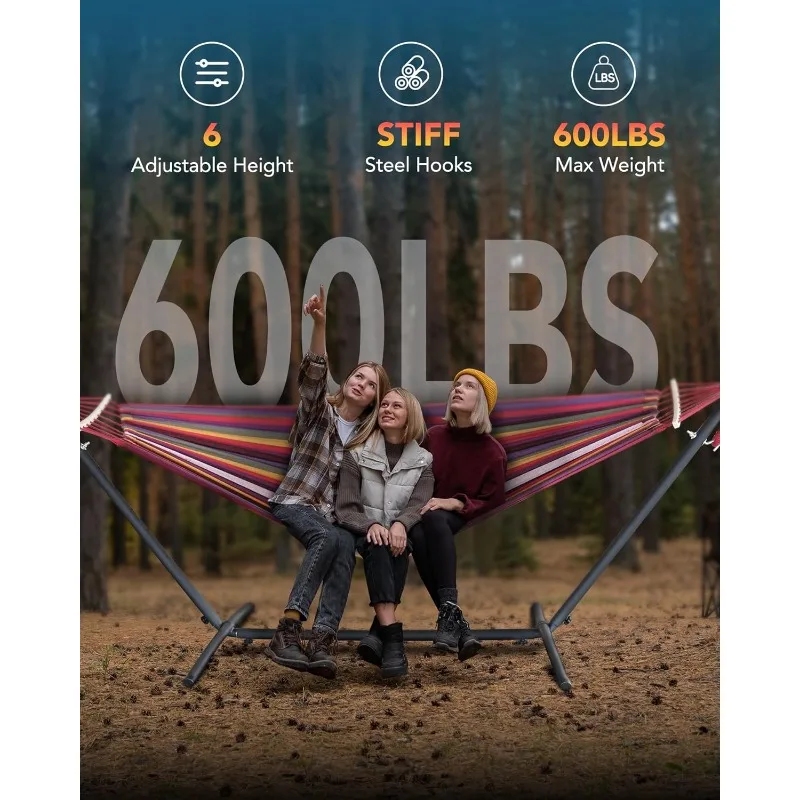
3.1.2. Nylon
Nylon hammocks offer exceptional strength-to-weight ratio, making them the go-to choice for portable options and camping enthusiasts.
Different Types
– Ripstop Nylon: Features a reinforced weave pattern that prevents tears from spreading
– Parachute Nylon: Lightweight with excellent tensile strength, similar to parachute material
– Diamond Weave Nylon: Provides additional durability through pattern construction
Key Strengths
– Incredibly lightweight while maintaining impressive strength
– Superior packability for travel and hiking
– Quick-drying properties after rain or morning dew
– Excellent tensile strength and resistance to stretching
– Smooth texture that resists dirt accumulation
– Available in various thicknesses (measured in denier)
Limitations
– Less UV resistant than polyester unless specially treated
– Can degrade faster in constant sun exposure
– May feel slippery for some users
– Typically less colorfast than polyester or premium fabrics
Best Applications
Nylon hammocks shine for:
– Camping and backpacking where weight matters
– Travel hammocks that need to pack small
– Situations requiring frequent setup and takedown
– Emergency or backup outdoor sleeping options
Care and Maintenance
– Hand washing typically recommended
– Air drying works best
– Avoid harsh detergents that can strip protective coatings
– Store dry in a cool place when not in use
Our ultralight camping hammock sets showcase the best qualities of nylon, prioritizing portability without sacrificing strength.
3.1.3. Olefin (Polypropylene)
Olefin represents one of the most advanced synthetic options for outdoor hammocks, offering exceptional durability with environmentally friendly credentials.
Manufacturing Process
Olefin is created through polymerization of propylene gas. Unlike many other synthetics, the color is added during the manufacturing process (solution-dyed), not applied to the surface afterward. This means the color permeates throughout the fiber, not just on the surface.
Environmental Benefits
– 100% recyclable material
– Production requires less energy than many other synthetics
– No harmful chemicals needed for coloring
– Minimal water used in production
Strengths
– Inherently stain-resistant as it doesn’t absorb liquids
– Exceptionally colorfast even in intense sunlight
– Naturally resistant to mold, mildew, and bacteria
– Withstands cleaning with bleach without damage
– Lightweight but strong
– Dries extremely quickly after exposure to water
Limitations
– Generally more expensive than basic polyester options
– Can feel less soft than cotton or premium acrylics
– Limited stretch (which can be a positive for stability)
Best Use Scenarios
Olefin hammocks excel in:
– Poolside or beachfront locations
– Areas with harsh sunlight
– Situations where frequent cleaning is necessary
– Eco-conscious outdoor installations
Maintenance Requirements
– Can be cleaned with bleach solutions if needed
– Resistant to most household chemicals
– Simple hosing off often removes most dirt
– Minimal care needed to maintain appearance
3.2. Premium Engineered Fabrics
3.2.1. Sunbrella (Solution-Dyed Acrylic)
Widely recognized as the gold standard for outdoor fabrics, Sunbrella offers unmatched performance for those willing to invest in premium quality.
Manufacturing Process
Sunbrella fabrics use a solution-dying process where color is added to the acrylic solution before the fibers are formed. This creates color throughout the entire fiber—not just on the surface—leading to exceptional colorfastness.
Industry-Leading UV Protection
– Maintains 98% of color and strength after 1,600 hours of UV testing
– Typical fabrics start showing significant fading at just 300 hours
– Specially engineered UV-resistant dyes and stabilizers
– Can withstand years of direct sunlight without significant degradation
Water Resistance Properties
– Water-repellent but not waterproof
– Allows moisture to evaporate instead of trapping it
– Engineered to prevent mildew and mold growth
– Dries quickly after rain
Longevity Comparison
Sunbrella fabrics typically last 5-10 years in full outdoor exposure—often 3-4 times longer than standard polyester or untreated fabrics. This extended lifespan offsets the higher initial cost.
Premium Price Considerations
– 2-3 times more expensive than standard polyester options
– Long-term value often exceeds the initial price difference
– Warranty coverage (typically 5 years) adds additional value
– Reduced replacement frequency makes it economical over time
Best Applications and Care
– Ideal for permanent outdoor installations
– Perfect for high-value hammocks meant to last many years
– Simple cleaning with mild soap and water
– Resistant to most household cleaners and even bleach solutions
3.2.2. Proprietary Performance Fabrics
Many quality hammock manufacturers have developed their own specialized fabrics to achieve specific performance characteristics.
Overview of Brand-Specific Fabrics
– HamacTex: Engineered for enhanced UV resistance with added softness
– DuraCord: Combines the softness of cotton with the durability of synthetic fibers
– WeatherMAX: Highly breathable with superior water shedding capabilities
– OutdoorTex: Focused on mildew resistance and color retention
Performance Benefits
– Often designed to address specific weaknesses in standard fabrics
– May offer unique combinations of properties (e.g., cotton-like feel with synthetic durability)
– Frequently tested against industry standards to verify claims
– May include specialized treatments for water and stain resistance
Value Proposition
– Usually positioned between standard synthetics and premium options like Sunbrella
– Often provide 80% of premium fabric benefits at 60-70% of the cost
– May offer specialized features for specific climate challenges
– Typically backed by manufacturer warranties
Our heavy-duty hammock sets incorporate these performance fabrics to ensure both comfort and exceptional durability.
4. Natural vs. Synthetic Materials: Making the Right Choice
When deciding between natural and synthetic hammock fabrics for outdoor use, understanding the fundamental differences helps you make a choice that aligns with your priorities.
Cotton for Outdoor Use: An Honest Assessment
Superior Comfort and Breathability
Cotton remains unmatched in terms of:
– Natural softness against the skin
– Excellent breathability in hot weather
– A traditional, classic feel
– Ability to conform to body contours
Significant Limitations
However, cotton presents serious challenges for outdoor use:
– Absorbs and retains moisture, leading to mildew and rot
– Fades quickly in sunlight (as little as 1-2 months of exposure)
– Weakens significantly when wet
– Requires regular maintenance
– Can shrink after exposure to rain
– Takes much longer to dry than synthetics
Viable Scenarios for Cotton Outdoors
Cotton hammocks can work outdoors in specific circumstances:
– Under covered porches or gazebos
– In dry climates with minimal humidity
– For seasonal use with indoor storage during off-seasons
– Where daily maintenance is possible
Treatments That Improve Performance
Some treatments can enhance cotton’s outdoor durability:
– Water-repellent coatings (though these wear off over time)
– UV-resistant dyes (which extend color life but not fiber strength)
– Mildew inhibitors (helpful but not completely preventative)
Cotton-Synthetic Blends
Blended fabrics attempt to capture the best properties of both worlds:
– 60/40 cotton-polyester blends offer improved softness with better durability
– Cotton outside with synthetic core provides natural feel with enhanced strength
– Quilted designs often combine cotton comfort layers with synthetic backing
These blends typically perform better outdoors than pure cotton but still require more care than fully synthetic options.
Environmental Considerations
Natural Fibers
– Biodegradable at end of life
– Renewable resource (for organic cotton)
– Less energy-intensive production
– No microplastic shedding
Synthetic Fibers
– Longer lifespan reduces replacement frequency
– Many are now recyclable (especially polyester and olefin)
– Require fewer resources for maintenance
– Some newer options incorporate recycled materials
Comparison Table: Natural vs. Synthetic
| Factor | Cotton | Polyester | Nylon | Olefin | Sunbrella |
|---|---|---|---|---|---|
| Weather Resistance | Poor | Very Good | Good | Excellent | Superior |
| Durability | Poor-Fair | Good | Good | Very Good | Excellent |
| Comfort | Excellent | Fair | Fair | Good | Very Good |
| Maintenance | High | Low | Low | Very Low | Very Low |
| Environmental Impact | Medium | Medium-High | High | Low-Medium | Medium |
| Initial Cost | Low | Low-Medium | Medium | Medium-High | High |
| Lifespan (Outdoor) | 1-2 years | 3-5 years | 2-4 years | 5-7 years | 7-10+ years |
Our quilted fabric hammock sets often feature strategic blends of materials to maximize comfort while maintaining outdoor durability.
5. Fabric Selection Guide Based on Climate and Usage
The perfect hammock fabric for one environment might be completely wrong for another. This section helps you match your fabric choice to your specific conditions and how you plan to use your hammock.
Matching Fabrics to Specific Climate Conditions
Hot and Humid Environments
In tropical or subtropical climates where moisture is a constant concern:
– Olefin/polypropylene offers superior mold and mildew resistance
– Quick-drying nylon prevents moisture accumulation
– Solution-dyed fabrics resist fading in intense sun
– Avoid: Cotton, which will quickly develop mold issues
Dry, High-UV Exposure Areas
For desert regions or areas with intense, direct sunlight:
– Sunbrella and other solution-dyed acrylics provide superior UV protection
– Polyester with UV inhibitors maintains strength longer
– Tightly woven fabrics prevent UV degradation
– Avoid: Untreated nylon, which can weaken in constant sun exposure
Seasonal/Mixed Weather Locations
For areas with distinct seasons and varied conditions:
– Polyester offers good all-around performance
– DuraCord and other hybrid materials adapt well to changing conditions
– Weather-treated fabrics with moisture management
– Avoid: Specialty fabrics designed for extreme conditions (unnecessary expense)
Areas with Frequent Precipitation
For rainy regions or locations with heavy morning dew:
– Olefin sheds water exceptionally well
– Polyester with water-repellent treatment stays dry
– Quick-drying nylon recovers fast after rain
– Avoid: Cotton and cotton blends, which remain damp for extended periods
Usage Patterns and Fabric Selection
Permanent Outdoor Installation
For hammocks that will remain outside year-round:
– Sunbrella or solution-dyed acrylics offer longest lifespan
– Olefin provides excellent weather resistance at a lower price point
– Heavy-duty polyester with UV and water protection
– Avoid: Any untreated fabrics regardless of type
Seasonal Use with Storage
If you’ll store your hammock during harsh months:
– Standard polyester offers good durability with proper storage
– Treated nylon provides lightweight convenience
– Cotton-synthetic blends become viable options
– Avoid: Investing in premium materials if not needed for your usage pattern
Frequent Travel/Portable Requirements
For hammocks that will be packed and transported often:
– Parachute nylon offers unmatched weight-to-strength ratio
– Ripstop nylon prevents damage during frequent handling
– Lightweight polyester balances durability and packability
– Avoid: Heavy fabrics that add unnecessary bulk and weight
Indoor-Outdoor Versatility
For hammocks that move between environments:
– DuraCord and other comfort-focused synthetics
– Medium-weight polyester with soft finish
– Cotton-polyester blends with weather treatment
– Avoid: Extremely technical fabrics that sacrifice comfort for weather resistance
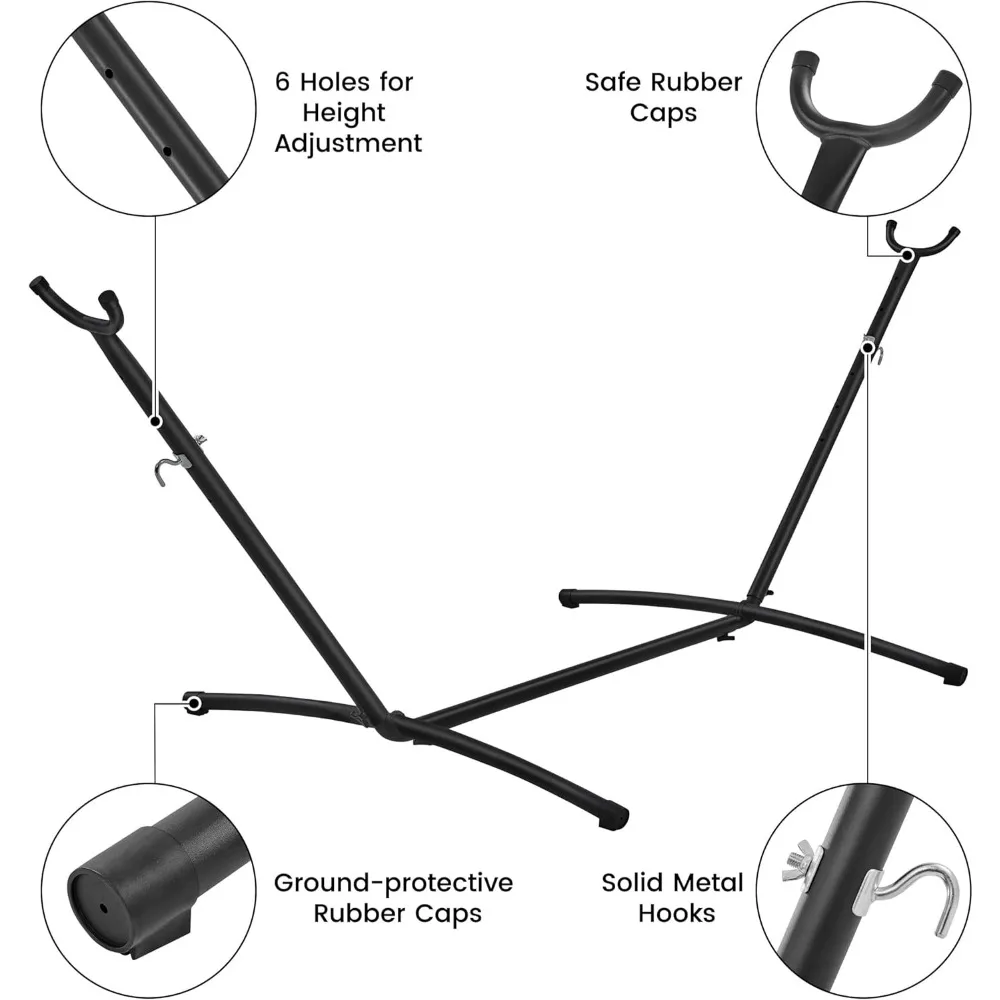
Understanding how to create the perfect hammock haven involves selecting fabric appropriate for your specific environment.
For areas with intense sun or unpredictable weather, consider our hammock sets with canopies to provide additional protection.
6. Weight Capacity and Safety Considerations
The fabric of your hammock directly impacts its weight capacity and safety. Understanding this relationship helps you choose a hammock that will safely support you and anyone else who might use it.
Understanding Fabric Strength and Weight Capacity
Fabric strength contributes to a hammock’s overall weight capacity in several ways:
– Tensile strength determines how much force the fabric can withstand before tearing
– Stretch resistance prevents sagging and maintains proper support
– Seam strength ensures the fabric doesn’t separate at connection points
– Long-term durability maintains these properties over time
Denier Ratings Explained
Denier (D) measures the thickness of individual fibers in a fabric. Higher numbers indicate thicker, stronger fibers:
- 70D: Typical for ultralight camping hammocks (250-300 lb capacity)
- 210D: Common in standard outdoor hammocks (400-450 lb capacity)
- 420D: Found in heavy-duty options (500+ lb capacity)
However, denier alone doesn’t determine strength. The weave pattern, treatment, and overall construction also matter significantly.
Single vs. Double Hammock Requirements
Double hammocks need additional strength considerations:
– Typically require at least 400-500 lb (181-227 kg) capacity
– Need more tear resistance due to uneven weight distribution
– Benefit from reinforced edges and attachment points
– Usually utilize heavier denier fabrics than single models
Safety Margins and Why They Matter
Quality hammock manufacturers build in safety margins:
– Rated capacities are typically 20-30% below actual breaking point
– This accounts for dynamic forces (getting in/out, movement)
– Aging and environmental exposure gradually reduce maximum capacity
– A good safety margin prevents sudden failure
Warning Signs of Fabric Weakening
Monitor your hammock for these indicators of potential failure:
– Visible fraying at edges or stress points
– Thinning fabric in the center or sides
– Color fading (often indicates UV damage and weakening)
– Stretching that doesn’t recover when weight is removed
– Small tears or pulled threads (can quickly become larger)
Understanding proper hammock installation requirements and safety guidelines helps prevent accidents and extend your hammock’s lifespan.
For couples or those who prefer extra space, our double two-person hammock sets are engineered with reinforced fabrics to safely support two adults.
7. Color, Pattern, and Design Considerations
While durability and weather resistance are critical for outdoor hammocks, aesthetic elements like color and pattern also play important roles in both appearance and performance.
How Fabric Type Affects Color Vibrancy and Longevity
Different fabrics hold and maintain color in distinct ways:
– Polyester generally retains colors well, with minimal fading
– Nylon colors tend to fade faster unless specially treated
– Cotton colors fade quickly in outdoor exposure
– Solution-dyed fabrics (like Sunbrella and Olefin) maintain color longest
Solution-Dyed vs. Surface-Printed Fabrics
The method used to color fabric significantly impacts its performance:
Solution-Dyed Process
– Color added to liquid polymer before fibers are formed
– Color permeates throughout the entire fiber
– Extremely resistant to fading and color loss
– Cannot be bleached out or easily damaged
– Maintains appearance much longer outdoors
Surface-Printed Process
– Color applied to already-woven fabric surface
– Color only penetrates outer layer of fibers
– More susceptible to fading and wear
– Often shows discoloration at crease points
– Typically less expensive initially
UV Effects on Different Colors and Patterns
Not all colors respond the same way to sunlight exposure:
– Dark blues and reds typically fade faster than other colors
– Yellows and greens often show UV damage more visibly
– Patterns can hide fading better than solid colors
– Multi-colored designs may fade unevenly
– Bright whites may yellow without UV protection
Design Options Available in Different Fabric Types
Each fabric category offers different design possibilities:
– Polyester accommodates vibrant prints and patterns
– Nylon works well with solid colors and simple designs
– Premium acrylics offer sophisticated patterns and textures
– Olefin provides excellent color options with superior longevity
– Cotton blends allow for traditional striped and quilted patterns
Balancing Aesthetics with Practical Performance
When selecting color and pattern, consider:
– Higher exposure locations benefit from fade-resistant fabrics
– Light colors show dirt less in dusty environments
– Patterns hide minor stains better than solids
– Classic designs tend to remain stylish longer
– The hammock’s surroundings and how colors will complement them
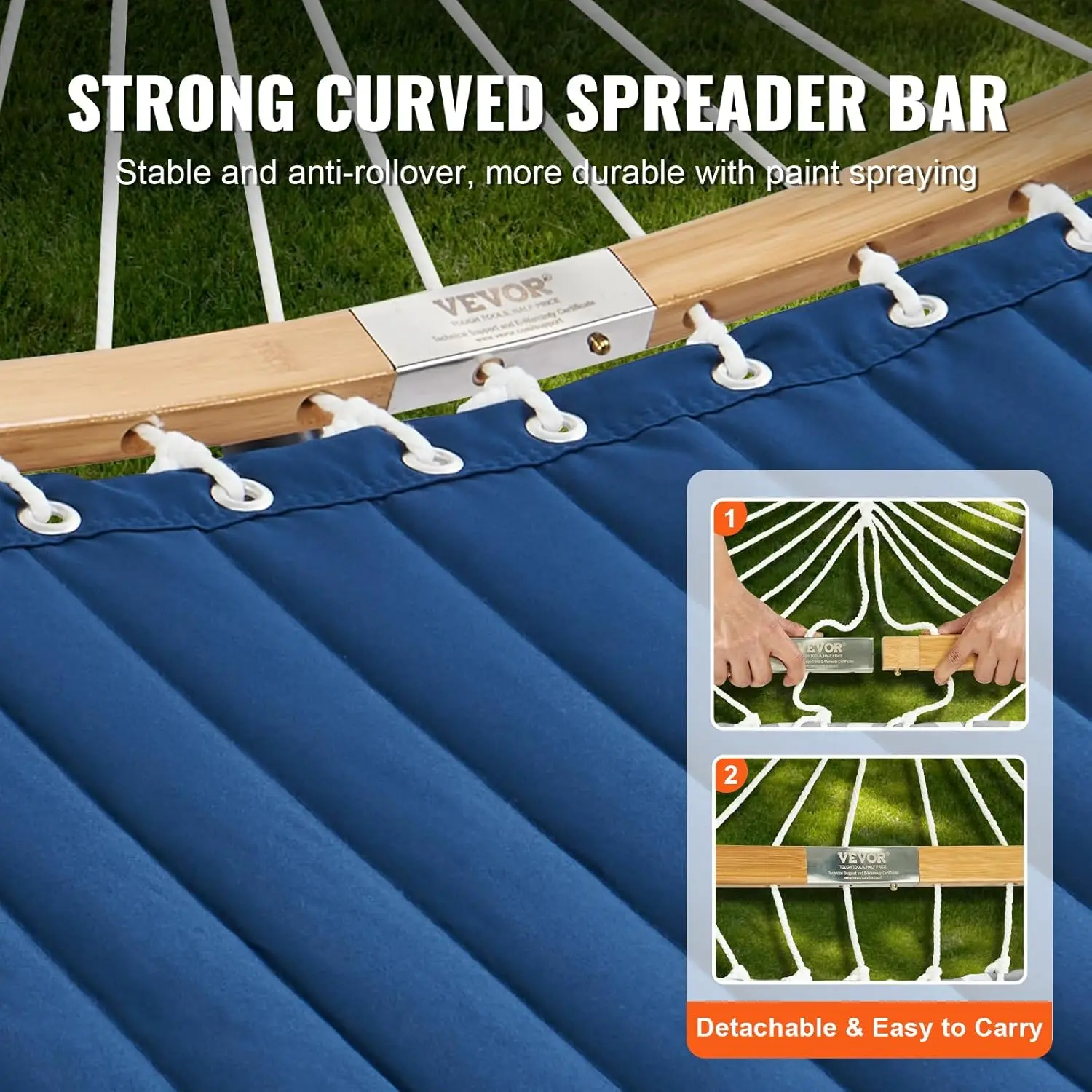
8. Caring for Your Outdoor Hammock Fabric
Proper maintenance significantly extends your hammock’s lifespan. Different fabrics require specific care approaches to maintain their appearance and functionality.
General Maintenance Principles for All Outdoor Hammocks
Regardless of fabric type, these practices help preserve any outdoor hammock:
– Remove debris (leaves, twigs) regularly
– Don’t leave hammocks in standing water
– Brush off dirt before it becomes embedded
– Address stains promptly before they set
– Allow complete drying before storage
– Store in dry, protected areas during extreme weather
– Keep away from fire pits and grills
Cleaning Techniques by Fabric Type
Polyester and Nylon Care
- Brush off loose dirt and debris
- Prepare a solution of mild soap and lukewarm water
- Gently scrub fabric with a soft brush
- Rinse thoroughly until water runs clear
- Hang to dry completely before use or storage
- Avoid harsh detergents or bleach
Olefin/Polypropylene Maintenance
- Remove surface dirt by brushing or hosing off
- For stubborn stains, use a mild bleach solution (1:10 ratio)
- Scrub gently with a soft brush
- Rinse completely
- Air dry (dries very quickly)
- No special treatment needed for storage
Sunbrella and Premium Fabric Care
- Brush off loose dirt
- Mix ¼ cup (59ml) mild soap per gallon (3.8L) of lukewarm water
- Use a soft brush to clean
- Allow solution to soak into fabric for up to 15 minutes
- Rinse thoroughly
- Air dry
- For tough stains, a diluted bleach solution is safe (check manufacturer instructions)
Cotton and Natural Fabric Preservation
- Brush off surface dirt
- Hand wash with mild soap and cool water
- Rinse completely to remove all soap
- Hang to dry thoroughly (may take longer than synthetics)
- Never store damp
- Consider applying fabric protector spray after cleaning
- Store indoors during extended periods of non-use
Proper Storage Practices to Extend Lifespan
- Ensure hammock is completely dry before storage
- Store in breathable cotton or mesh bags, not plastic
- Keep in cool, dry locations away from direct sunlight
- Avoid compressing fabric tightly for long periods
- Consider using cedar blocks to deter insects (for natural fabrics)
Dealing with Common Issues
Mold and Mildew Removal
- Mix one cup (237ml) of bleach with one gallon (3.8L) of water (for synthetics only)
- Apply to affected areas with soft brush
- Let sit for 15 minutes
- Rinse thoroughly
- Air dry in direct sunlight if possible
- For natural fabrics, use vinegar solution instead of bleach
Stain Treatment
- Oil-based stains: Apply cornstarch to absorb, then clean normally
- Berry stains: Treat quickly with lemon juice and salt
- Sunscreen stains: Dish soap and warm water, then regular cleaning
- Tree sap: Freeze with ice cube, scrape off, then clean
Addressing UV Damage
- Rotate hammock orientation periodically
- Apply UV protectant sprays to natural fabrics
- Consider shade solutions for areas with intense sun
- Replace significantly weakened hammocks for safety
Repairs for Small Tears or Damage
- Use fabric repair tape for temporary fixes
- Patch kits work well for small holes
- Ripstop nylon tears can be repaired with specialized tape
- Consider professional repair for expensive hammocks
Finding the best indoor-outdoor hammock locations can significantly reduce maintenance needs and extend your hammock’s lifespan.
9. Beyond Fabric: Other Important Hammock Components
While fabric is a critical element of any hammock, several other components work together with the fabric to create a complete, functional system.
How Suspension Systems Interact with Fabric Choices
The suspension system must complement the fabric type:
– Heavier fabrics require stronger, less elastic suspension
– Lightweight nylon hammocks pair well with adjustable straps
– Spreader bar hammocks need specialized attachments to maintain tension
– Rope-to-fabric transition points experience the most stress
Key suspension considerations include:
– Weight capacity matching the fabric’s strength
– Weather resistance comparable to the fabric
– UV protection to prevent premature failure
– Stretch characteristics that complement the fabric
Hardware Considerations
Quality hardware directly impacts hammock performance and safety:
– Carabiners: Look for marine-grade or climbing-rated options that won’t corrode
– S-hooks: Should be thick enough to support full weight without bending
– Rings: Solid stainless steel or galvanized options resist rust
– Spreader Bars: Hardwood or aluminum construction provides stability without excess weight
The finish on metal components matters significantly:
– Powder-coated finishes resist chipping and scratching
– Stainless steel prevents rust in humid environments
– Galvanized hardware offers good protection at lower cost
– Avoid uncoated metals that will quickly corrode outdoors
Stitching and Seam Construction Importance
The strongest fabric becomes the weakest link with poor stitching:
– Triple-stitched seams increase weight capacity by 20-30%
– Reinforced stress points prevent tearing at connection areas
– UV-resistant thread prevents seam failure
– Box-X patterns distribute weight more effectively than straight stitching
High-quality hammocks feature:
– Visible reinforcement at all suspension points
– Consistent, tight stitching throughout
– Thread material matched to the fabric’s durability
– Edge binding to prevent fraying
Integrated Features and Fabric Compatibility
Modern hammocks often include additional features that must work harmoniously with the fabric:
– Storage pockets should be made from the same or compatible material
– Integrated bug nets need to attach without creating stress points
– Pillow attachments require reinforced connection points
– Weather shields must match the hammock’s breathability characteristics
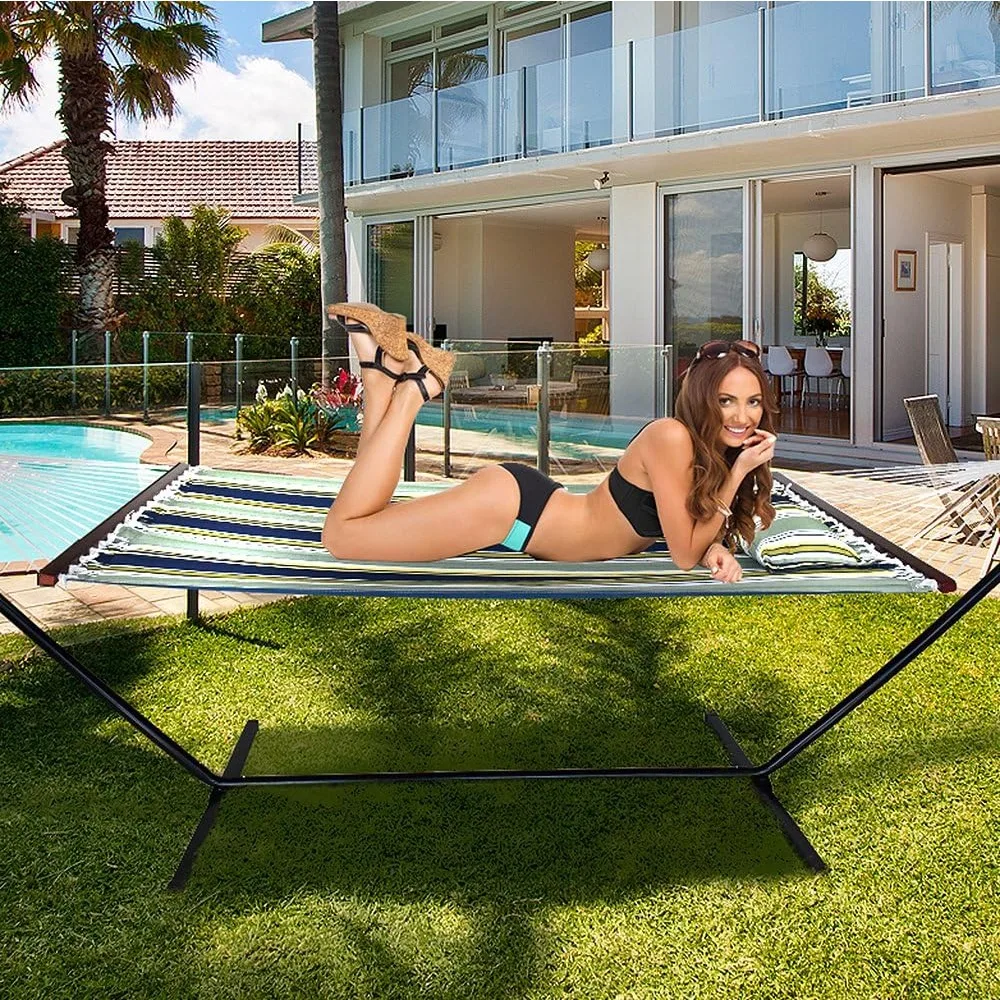
Our spreader bar hammock sets feature reinforced attachment points where the fabric meets the hardware, ensuring long-term durability.
For those concerned about insects, our camping hammock sets with bug nets integrate protective mesh with performance fabrics.
10. FAQs About Outdoor Hammock Fabrics
Can I leave my hammock outside year-round?
This depends entirely on the fabric type. Premium synthetic fabrics like Sunbrella and Olefin can remain outdoors year-round in most climates with minimal impact on longevity. Standard polyester hammocks should be brought in during severe weather and winter months in harsh climates. Cotton and natural fiber hammocks should never be left outside permanently, as they’ll quickly develop mold and deteriorate.
Even with weather-resistant fabrics, storing your hammock during extended periods of non-use will significantly extend its lifespan.
How long do different outdoor hammock fabrics typically last?
With proper care and appropriate use, fabric lifespans vary considerably:
– Premium acrylics (Sunbrella): 7-10+ years
– Olefin/polypropylene: 5-7 years
– Quality polyester: 3-5 years
– Nylon: 2-4 years (highly dependent on UV exposure)
– Cotton (left outdoors): 1-2 years
These estimates assume regular use in moderate conditions. Harsh environments, improper care, or constant exposure will reduce these timeframes.
Are outdoor hammocks waterproof?
Most outdoor hammocks are water-resistant rather than completely waterproof. The difference is important:
– Water-resistant fabrics repel light moisture but will eventually allow water through
– Waterproof fabrics have sealed surfaces that prevent any water penetration
For most outdoor relaxation, water-resistant fabrics are preferable as they:
– Allow airflow and breathability
– Dry faster after exposure to moisture
– Feel more comfortable against skin
– Don’t trap humidity inside the hammock
Only specialized camping hammocks with rain flies would be considered truly waterproof systems.
Can outdoor hammocks be used indoors?
Absolutely! Outdoor hammocks work perfectly indoors, offering several advantages:
– Durability for family use
– Resistance to accidental spills
– Easy cleaning and maintenance
– Versatility for indoor-outdoor transitions
The main consideration is that some outdoor fabrics may feel slightly less soft than those designed exclusively for indoor use. Many people use their indoor vs outdoor hammocks interchangeably, maximizing their versatility.
What’s the difference between “weather-resistant” and “weatherproof”?
These terms indicate different levels of protection:
Weather-resistant fabrics:
– Repel moisture for limited periods
– Withstand UV exposure without immediate damage
– Resist mold and mildew but aren’t immune
– Require some maintenance and care
Weatherproof fabrics:
– Block water completely
– Feature sealed or treated surfaces
– Often include multiple protective layers
– May sacrifice some breathability for protection
For most hammock uses, weather-resistant fabrics offer the best balance of protection and comfort. Truly weatherproof hammocks are usually specialized for camping or extreme conditions.
Understanding whether it’s safe to hang a hammock indoors helps you make the most of your hammock year-round.
11. Making Your Final Decision: Fabric Selection Checklist
When you’re ready to choose your hammock fabric, this structured approach will help you prioritize what matters most for your specific situation.
Prioritize Your Needs
Start by ranking these factors in order of importance to you:
1. Durability: How long do you expect the hammock to last?
2. Weather Resistance: Will it face harsh conditions?
3. Comfort: How important is the feel against skin?
4. Aesthetics: Does appearance matter significantly?
5. Maintenance: How much care are you willing to provide?
6. Price: What’s your budget constraint?
Your ranking creates a personalized decision framework. For example, someone prioritizing durability and low maintenance would lean toward Olefin or Sunbrella, while someone emphasizing comfort might consider a cotton-blend option with proper protection.
Climate Assessment Considerations
Be honest about your local conditions:
– Temperature Range: Extreme heat or cold requires more durable fabrics
– Humidity Levels: High humidity demands mold-resistant synthetics
– Rainfall Amount: Frequent rain requires quick-drying materials
– Sun Exposure: Intense sun necessitates high UV resistance
– Seasonal Changes: Dramatic shifts may require storage during extreme seasons
Usage Pattern Evaluation
How you’ll use the hammock significantly impacts fabric needs:
– Frequency: Daily use demands higher durability
– Duration: Longer lounging sessions increase comfort importance
– User Type: Family use with children requires stain resistance
– Permanence: Fixed installation vs. occasional setup
– Travel Needs: Portability requirements favor lightweight options
Budget Constraints and Value Analysis
Consider the total cost of ownership, not just purchase price:
– Higher upfront cost often means longer lifespan
– Premium fabrics may offer 2-3 times the durability at 1.5-2 times the price
– Replacement frequency affects long-term value
– Maintenance costs (cleaners, protectants) vary by fabric type
Testing Fabric Before Purchase
Whenever possible, experience the fabric firsthand:
– Feel samples for texture and comfort
– Check the weight and strength personally
– See how different colors look in outdoor lighting
– Compare options side-by-side when available
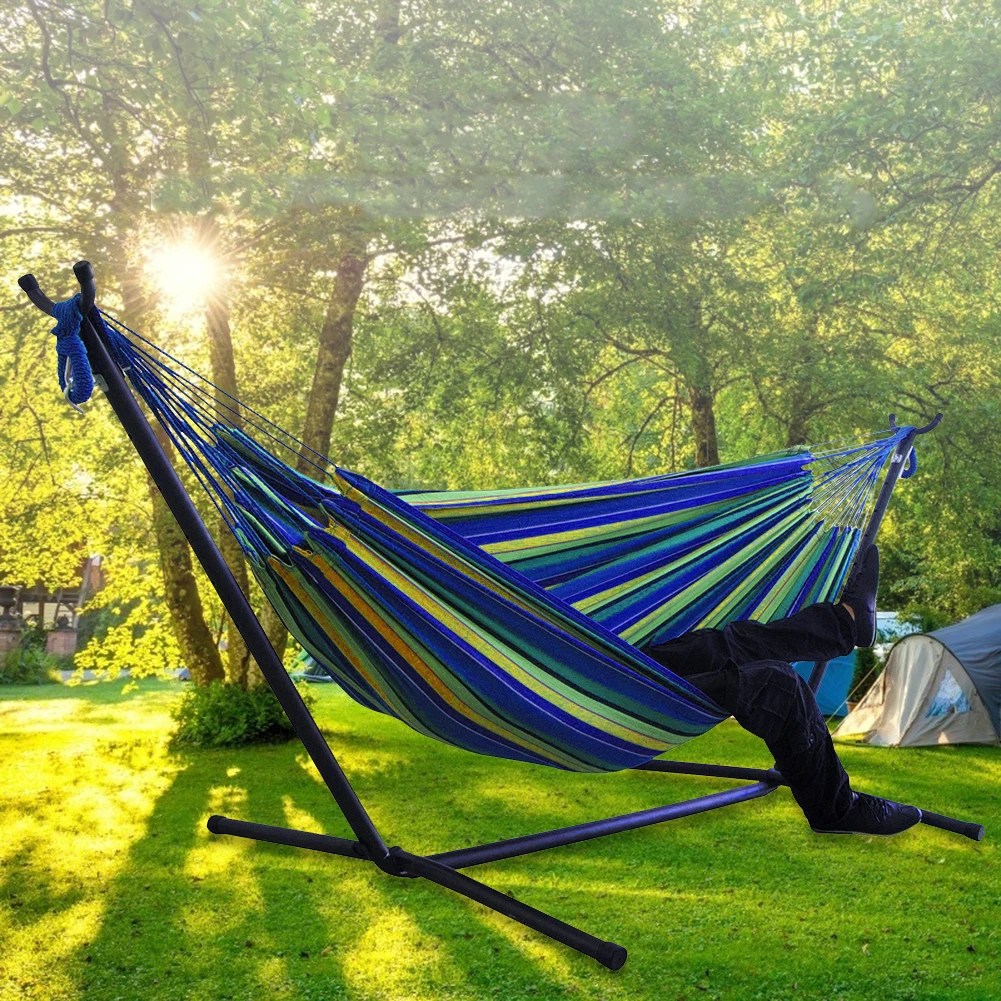
Finding the perfect hammock placement for your home and garden helps you determine the environmental factors your fabric will need to withstand.
Camping Hammock Sets with Bug Net, Ultralight Camping Hammock Sets
$139.72 Select options This product has multiple variants. The options may be chosen on the product pageClassic Wooden Stand Hammock Sets, Heavy Duty Hammock Sets
$1,061.68 Select options This product has multiple variants. The options may be chosen on the product pageHammock Sets with Canopy, Heavy Duty Hammock Sets
$286.31 Select options This product has multiple variants. The options may be chosen on the product pageDouble / Two Person Hammock Sets, Rope Hammock Sets
Double Traditional Cotton Rope Hammock with Extension Chains – 450 lbs Capacity for Backyard & Patio$292.98 Select options This product has multiple variants. The options may be chosen on the product pageHeavy Duty Hammock Sets, Wooden Arc Stand Hammock Sets
$878.66 Select options This product has multiple variants. The options may be chosen on the product page
12. Supplemental Content: Emerging Innovations in Hammock Fabrics
The world of outdoor fabrics continues to evolve, with manufacturers developing innovative solutions that enhance performance while addressing environmental concerns.
New Eco-Friendly Synthetic Options
Recent developments focus on sustainability without sacrificing performance:
– Recycled polyester made from post-consumer plastic bottles
– Bio-based nylon derived partially from plant sources
– Fabrics designed for complete recycling at end of life
– Manufacturing processes that reduce water and energy consumption
These eco-friendly options now achieve performance comparable to traditional synthetics, often with only a modest price premium.
Advanced Weatherproofing Technologies
New treatment approaches improve weather resistance:
– Molecular-level water repellents that don’t affect breathability
– UV inhibitors that integrate into the fiber structure rather than coating
– Multi-stage protective systems that address multiple elements simultaneously
– Self-cleaning surface treatments that reduce maintenance needs
Multi-Functional Fabrics
Modern hammock fabrics increasingly offer additional benefits:
– Thermoregulating properties that reflect heat in summer and retain it in cooler weather
– Anti-microbial treatments that prevent odor development
– Insect-repelling finishes that enhance outdoor comfort
– Stretch-recovery technologies that maintain shape over years of use
What to Watch for in the Future
Emerging trends suggest future developments in:
– Smart fabrics with UV monitoring capabilities
– Ultra-lightweight, high-strength materials adapted from aerospace applications
– Completely biodegradable synthetic options
– Customizable properties through modular design
Understanding indoor-outdoor hammock safety guidelines becomes even more important as fabrics evolve and offer new capabilities.
13. Supplemental Content: Common Myths About Outdoor Hammock Fabrics
Several misconceptions persist about outdoor hammock fabrics that can lead to poor purchasing decisions. Let’s separate fact from fiction.
Myth: Higher Denier Rating Always Means Better Quality
Reality: While denier measures fiber thickness, it’s just one factor in overall strength. A well-constructed 210D hammock with quality stitching and weave pattern can outperform and outlast a poorly made 420D option. Thread quality, weave pattern, and construction techniques matter just as much as fiber thickness.
Myth: All Synthetic Fabrics Feel Uncomfortable Against the Skin
Reality: Modern synthetic fabrics have evolved significantly. Many premium synthetics are engineered specifically for softness and comfort. Fabrics like DuraCord and high-end polyester blends can rival cotton in comfort while maintaining superior durability. The rough, plastic-like feel of early synthetics is largely a thing of the past in quality hammocks.
Myth: Cotton Hammocks Cannot Be Used Outdoors at All
Reality: While cotton isn’t ideal for permanent outdoor installation, it can work well in controlled outdoor environments. Cotton hammocks can thrive in covered areas like porches or under canopies, in dry climates, or with seasonal use and proper storage. Many traditional cotton hammocks have been enjoyed outdoors for generations with appropriate care and protection.
Myth: Waterproof Hammocks Are Always Better Than Water-Resistant Ones
Reality: Waterproof fabrics prevent both water coming in and moisture going out, which can create uncomfortable humidity and condensation inside the hammock. For most relaxation purposes, water-resistant fabrics provide better overall comfort while still offering practical protection from light rain and morning dew. Truly waterproof options are really only necessary for camping in adverse conditions.
Understanding the differences between the best places to hang a hammock indoors versus outdoors helps clarify when different fabric properties become more important.

